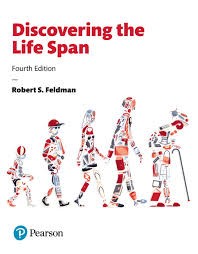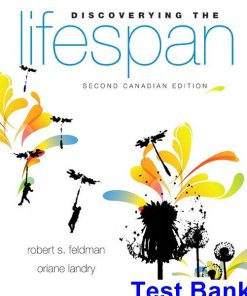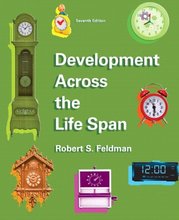Test Bank for Discovering the Life Span 4th Edition by Feldman
$35.00 Original price was: $35.00.$26.50Current price is: $26.50.
Test Bank for Discovering the Life Span 4th Edition by Feldman
This is completed downloadable of Test Bank for Discovering the Life Span 4th Edition by Feldman

Product Details:
- ISBN-10 : 0134577655
- ISBN-13 : 978-0134577654
- Author: Robert S. Feldman
A modular, manageable, meaningful survey of the life span
Discovering the Life Span provides a broad overview of the entire range of the human life, from the moment of conception through death. Utilizing a flexible, modular organization, author Robert Feldman covers the life span chronologically and focuses on physical, cognitive, and social and personality development within each stage of life. Feldman’s engaging and accessible writing style makes the material meaningful to students, and prepares them to apply content to their personal and future professional lives. In order to provide an up-to-date snapshot of the discipline, the Fourth Edition includes hundreds of new citations as well as coverage of a number of engaging contemporary topics.
Table of Content:
- Chapter 1 Introduction
- Module 1.1 Beginnings
- An Orientation to Lifespan Development
- Characterizing Lifespan Development: The Scope of the Field
- Cohort and Other Influences on Development: Developing With Others in a Social World
- Cultural Dimensions: How Culture, Ethnicity, and Race Influence Development
- Key Issues and Questions: Determining the Nature—and Nurture—of Lifespan Development
- Continuous Change Versus Discontinuous Change
- Critical and Sensitive Periods: Gauging the Impact of Environmental Events
- Lifespan Approaches Versus a Focus on Particular Periods
- The Relative Influence of Nature and Nurture on Development
- Review, Check, and Apply
- Module 1.2 Theoretical Perspectives on Lifespan Development
- The Psychodynamic, Behavioral, and Cognitive Perspectives
- The Psychodynamic Perspective: Focusing on the Inner Person
- The Behavioral Perspective: Focusing on Observable Behavior
- The Cognitive Perspective: Examining the Roots of Understanding
- The Humanistic, Contextual, and Evolutionary Perspectives
- The Humanistic Perspective: Concentrating on Uniquely Human Qualities
- The Contextual Perspective: Taking a Broad Approach to Development
- Evolutionary Perspectives: Our Ancestors’ Contributions to Behavior
- Why “Which Approach Is Right?” Is the Wrong Question
- Review, Check, and Apply
- Module 1.3 Research Methods
- Theories, Hypotheses, and Correlational Studies
- Theories and Hypotheses: Posing Developmental Questions
- Choosing a Research Strategy: Answering Questions
- Correlational Studies
- Experiments: Determining Cause and Effect
- The Basics of Experiments
- Theoretical and Applied Research: Complementary Approaches
- From Research to Practice
- Measuring Developmental Change
- Ethics and Research
- Becoming an Informed Consumer of Developmentthinking Critically About “Expert” Advice
- Review, Check, and Apply
- Summary 1: Putting It All Together: Introduction
- Chapter 2 The Start of Life
- Module 2.1 Prenatal Development
- Earliest Development
- Genes and Chromosomes: The Code of Life
- The Basics of Genetics: The Mixing and Matching of Traits
- Genetic Counseling: Predicting the Future From the Genes of the Present
- From Research to Practice: Prenatal Screenings Are Not Diagnoses
- The Interaction of Heredity and Environment
- The Role of the Environment in Determining the Expression of Genes: From Genotypes to Phenotypes
- Genetics and the Environment: Working Together
- Cultural Dimensions: Cultural Differences in Physical Arousal: Might a Culture’s Philosophicaloutl
- Can Genes Influence the Environment?
- Review, Check, and Apply
- Module 2.2 Prenatal Growth and Change
- The Prenatal Period
- The Moment of Conception and the Onset of Development
- Pregnancy Problems
- The Prenatal Environment: Threats to Development
- Becoming an Informed Consumer of Developmentoptimizing the Prenatal environment
- Review, Check, and Apply
- Module 2.3 Birth and the Newborn Infant
- Birth
- From Labor to Delivery
- Approaches to Childbirth: Where Medicine and Attitudes Meet
- Becoming an Informed Consumer of DevelopmentDealing With labor
- Birth Complications
- Preterm Infants and Postmature Babies
- Cesarean Delivery: Intervening in the Process of Birth
- Stillbirth, Infant Mortality, and Postpartum Depression
- Cultural Dimensions: Overcoming Racial and Cultural Differences in Infant Mortality
- The Competent Newborn
- Physical Competence: Meeting the Demands of a New Environment
- Sensory Capabilities: Experiencing the World
- Early Learning Capabilities
- Social Competence: Responding to Others
- Review, Check, and Apply
- Summary 2: Putting It All Together: The Start of Life
- Chapter 3 Infancy
- Growth and Stability
- Physical Growth: The Rapid Advances of Infancy
- The Nervous System and Brain: The Foundations of Development
- Integrating the Bodily Systems: The Life Cycles of Infancy
- Motor Development
- Reflexes: Our Inborn Physical Skills
- Motor Development in Infancy: Landmarks of Physical Achievement
- Nutrition in Infancy: Fueling Motor Development
- Cultural Dimensions: Motor Development Across Cultures
- The Development of the Senses
- Experiencing the World: The Sensory Capabilities of Infants
- Multimodal Perception: Combining Individual Sensory Inputs
- Becoming an Informed Consumer of DevelopmentExercising Your Infant’s Body and Senses
- Review, Check, and Apply
- Module 3.2 Cognitive Development in Infancy
- Piaget’s Approach to Cognitive Development
- Key Elements of Piaget’s Theory
- Appraising Piaget: Support and Challenges
- Information-Processing Approaches to Cognitive Development
- The Foundations of Information Processing: Encoding, Storage, and Retrieval
- From Research to PracticeBrain growth May Be responsible for Infantile Amnesia
- Individual Differences in Intelligence: Is One Infant Smarter Than Another?
- Becoming an Informed Consumer of Development: What Can You Do to Promote Infants’ Cognitive Develo
- The Roots of Language
- The Fundamentals of Language: From Sounds to Symbols
- The Origins of Language Development
- Cultural Dimensions: Is Infant-Directed Speech Similar Across All Cultures?
- Review, Check, and Apply
- Module 3.3 Social and Personality Development in Infancy
- Developing the Roots of Sociability
- Emotions in Infancy: Do Infants Experience Emotional Highs and Lows?
- The Development of Self
- Forming Relationships
- Attachment: Forming Social Bonds
- Cultural Dimensions: Does Attachment Differ Across Cultures?
- Infants’ Sociability With Their Peers: Infant–Infant Interaction
- Differences Among Infants
- Personality Development: The Characteristics That Make Infants Unique
- Family Life in the 21st Century
- Becoming an Informed Consumer of Development: Choosing the Right Infant Care Provider
- Review, Check, and Apply
- Summary 3: Putting It All Together: Infancy
- Chapter 4 The Preschool Years
- Module 4.1 Physical Development in the PreschoolYears
- The Growing Body
- Becoming an Informed Consumer of Developmentkeeping Preschoolers healthy
- Changes in Body Shape and Nutrition
- Health and Illness
- The Growing Brain
- Brain Lateralization
- The Links Between Brain Growth and Cognitive Development
- Motor Development
- Gross Motor Skills
- Fine Motor Skills
- Review, Check, and Apply
- Module 4.2 Cognitive Development in the Preschool Years
- Piaget’s Approach to Cognitive Development
- Piaget’s Stage of Preoperational Thinking
- Evaluating Piaget’s Approach to Cognitive Development
- Alternative Approaches: InformationProcessing Theory and Vygotsky
- Information-Processing Approaches to Cognitive Development
- Vygotsky’s View of Cognitive Development: Taking Culture Into Account
- The Growth of Language and Learning
- Language Development
- Informal and Formal Learning
- Cultural Dimensions: Preschools Around the World: Why Does the United Stateslag Behind?
- Review, Check, and Apply
- Module 4.3 Social and Personality Development in the Preschool Years
- Forming a Sense of Self
- Self-Concept in the Preschool Years
- Cultural Dimensions: Developing racial and ethnic awareness
- Gender Identity: Developing Femaleness and Maleness
- Friends and Family: Preschoolers’ Social Lives
- The Development of Friendships
- Preschoolers’ Theory of Mind: Understanding What Others Are Thinking
- From Research to Practice: How Children Learn to Become Better Liars
- Preschoolers’ Family Lives
- Becoming an Informed Consumer of Development: Disciplining Children
- Child Abuse, Neglect, and Resilience: The Hidden Side of Family Life
- Moral Development and Aggression
- Developing Morality: Following Society’s Rights and Wrongs
- Aggression and Violence in Preschoolers: Sources and Consequences
- Becoming an Informed Consumer of Development: Increasing Moral Behavior and Reducing Aggressionin Pr
- Review, Check, and Apply
- Summary 4: Putting It All Together: The Preschool Years
- Chapter 5 Middle Childhood
- Module 5.1 Physical Development in Middle Childhood
- The Growing Body
- Height and Weight Changes
- Nutrition and Obesity
- Becoming an Informed Consumer of Development: Keeping Children Fit
- Motor Development and Safety
- Leaps and Bounds: The Rapid Growth of Motor Skills
- Health and Safety During Middle Childhood
- Children With Special Needs
- Sensory Difficulties and Learning Disabilities
- Attention Deficit Hyperactivity Disorder
- Review, Check, and Apply
- Module 5.2 Cognitive Development in Middle Childhood
- Intellectual and Language Development
- Perspectives on Cognitive Development in Middle Childhood
- Language Development: What Words Mean
- Schooling: The Three Rs (and More) of Middle Childhood
- Reading: Learning to Decipher the Meaning Behind Words
- Educational Trends: Beyond the Three Rs
- Cultural Dimensions: Multicultural education
- Intelligence: Determining Individual Strengths
- Intelligence Benchmarks: Differentiating the Intelligent From the Unintelligent
- Below and Above Intelligence Norms: Intellectual Disabilities and Intellectual Giftedness
- Review, Check, and Apply
- Module 5.3 Social and Personality Development in Middle Childhood
- The Developing Self
- A Different Mirror: The Changing Ways Children View Themselves
- From Research to Practice The Danger of Inflated Praise
- Cultural Dimensions: Are Children of Immigrant Families Well Adjusted?
- Moral Development
- Relationships: Building Friendship in Middle Childhood
- Stages of Friendship: Changing Views of Friends
- Becoming an Informed Consumer of Development: Increasing Children’s Social Competence
- Gender, Race, and Friendships
- Family Life in Middle Childhood
- Families Today: A Variety of Constellations
- Challenges to Family Life
- Review, Check, and Apply
- Summary 5: Putting It All Together: Middle Childhood
- Chapter 6 Adolescence
- Module 6.1 Physical Development in Adolescence
- Physical Maturation
- Growth During Adolescence: The Rapid Pace of Physical and Sexual Maturation
- Nutrition, Food, and Eating Disorders: Fueling the Growth of Adolescence
- Brain Development and Thought: Paving the Way for Cognitive Growth
- Threats to Adolescents’ Well-Being
- Drugs, Alcohol, and Tobacco
- Becoming an Informed Consumer of Development: Hooked on drugs or Alcohol?
- Sexually Transmitted Infections
- Cultural Dimensions: Selling death: Pushing Smoking to the less Advantaged
- Review, Check, and Apply
- Module 6.2 Cognitive Development in Adolescence
- Cognitive Development
- Piagetian Approaches to Cognitive Development: Using Formal Operations
- Information-Processing Perspectives: Gradual Transformations in Abilities
- School Performance
- Adolescent School Performance: A Complex Picture
- Adolescents’ Media Use
- Review, Check, and Apply
- Module 6.3 Social and Personality Development in Adolescence
- Identity: Asking “Who Am I?”
- Self-Concept and Self-Esteem
- Perspectives on Identity Formation
- Depression and Suicide: Psychological Difficulties in Adolescence
- Becoming an Informed Consumer of Development: Preventing Adolescent Suicide
- Relationships: Family and Friends
- Family Ties: Changing Relations With Relations
- Relationships With Peers: The Importance of Belonging
- From Research to Practice Empathy in Adolescence
- Cultural Dimensions Race Segregation: The Great Divide of Adolescence
- Dating, Sexual Behavior, and Teenage Pregnancy
- Dating: Close Relationships in the Twenty-First Century
- Sexual Relationships
- Review, Check, and Apply
- Summary 6: Putting It All Together: Adolescence
- Chapter 7 Early Adulthood
- Module 7.1 Physical Development in Early Adulthood
- Physical Development and Health
- Physical Changes and Challenges
- Fitness, Diet, and Health
- Cultural Dimensions: How Cultural Beliefs Influence Health and Health Care
- Stress and Coping: Dealing With Life’s Challenges
- The Origins and Consequences of Stress
- Coping With Stress
- Review, Check, and Apply
- Module 7.2 Cognitive Development in Early Adulthood
- Cognitive Development and Intelligence
- Intellectual Growth and Postformal Thought
- Intelligence: What Matters in Early Adulthood?
- College: Pursuing Higher Education
- The Demographics of Higher Education: Who Attends College?
- The Effects of Gender Bias and Negative Stereotypes on College Performance
- Becoming an Informed Consumer of Development: When Do College Students Need Professional Help With t
- Review, Check, and Apply
- Module 7.3 Social and Personality Development in Early Adulthood
- Forging Relationships: Intimacy, Liking, and Loving During Early Adulthood
- Intimacy, Friendship, and Love
- From Research to Practice: Emerging Adulthood: not Quite there Yet!
- The Faces of Love
- Choosing a Partner: Recognizing Mr. or Ms. Right
- Cultural Dimensions: Gay and Lesbian Relationships: Men With Men and Women With Women
- The Course of Relationships
- Cohabitation, Marriage, and Other Relationship Choices: Sorting Out the Options of Early Adulthood
- Parenthood: Choosing to Have Children
- Work: Choosing and Embarking on a Career
- The Role of Work
- Picking an Occupation: Choosing Life’s Work
- Review, Check, and Apply
- Summary 7: Putting It All Together: Early Adulthood
- Chapter 8 Middle Adulthood
- Module 8.1 Physical Development in Middle Adulthood
- Physical Development and Sexuality
- Physical Transitions: The Gradual Change in the Body’s Capabilities
- Sexuality in Middle Adulthood: The True, the False, and the Controversial
- Health
- Wellness and Illness: The Ups and Downs of Middle Adulthood
- Heart Disease and Cancer: The Big Worries of Middle Adulthood
- Cultural Dimensions: Individual Variation in Health: Ethnic and Gender Differences
- Intelligence and Memory
- Does Intelligence Decline in Adulthood?
- How Does Aging Affect Memory?
- Becoming an Informed Consumer of Development: Effective Strategies for Remembering
- Review, Check, and Apply
- Module 8.3 Social and Personality Development in Middle Adulthood
- Personality Development
- Perspectives on Adult Personality Development
- Cultural Dimensions: Middle Age: In Some Cultures It Doesn’t Exist
- Stability Versus Change in Personality
- Relationships: Family in Middle Age
- Marriage and Divorce
- Family Evolutions
- Family Violence: The Hidden Epidemic
- Becoming an Informed Consumer of Development Dealing With Spousal Abuse
- Work and Leisure
- Work in Middle Adulthood: The Good and the Bad
- Cultural Dimensions: Immigrants on the Job: Making it in America
- Leisure Time: Life Beyond Work
- Review, Check, and Apply
- Summary 8: Putting It All Together: Middle Adulthood
- Chapter 9 Late Adulthood
- Module 9.1 Physical Development in Late Adulthood
- Physical Development in Late Adulthood
- Aging: Myth and Reality
- Physical Transitions in Older People
- The Senses: Sight, Sound, Taste, and Smell
- The Impact of Aging on Health
- Health Problems and Wellness in Older People
- Becoming an Informed Consumer of Development: Caring for People With Alzheimer’s Disease
- Approaches to Aging: Why Is Death Inevitable?
- Cultural Dimensions: Gender, Race, and Ethnic Differences in Average Life Expectancy: Separate Lives
- Review, Check, and Apply
- Module 9.2 Cognitive Development in Late Adulthood
- Intelligence
- Cognitive Functioning in Older People
- Recent Conclusions About the Nature of Intelligence in Late Adulthood
- Memory and Learning
- Memory
- Never Too Late to Learn
- Review, Check, and Apply
- Module 9.3 Social and Personality Development in Late Adulthood
- Personality Development and Successful Aging
- Continuity and Change in Personality During Late Adulthood
- Age Stratification Approaches to Late Adulthood
- Cultural Dimension: Show Culture Shapes the Way We Treat People in Late Adulthood
- Does Age Bring Wisdom?
- Successful Aging: What Is the Secret?
- From Research to Practice: Is Age really Just a State of Mind?
- The Daily Life of Late Adulthood
- Living Arrangements: The Places and Spaces of Their Lives
- Finances, Work, and Retirement
- Becoming an Informed Consumer of Development: Planning for—and Living—a Good Retirement
- Relationships: Old and New
- Marriage in the Later Years: Together, Then Alone
- Friends and Family in Late Adulthood
- Elder Abuse: Relationships Gone Wrong
- Review, Check, and Apply
- Summary 9: Putting It All Together: Late Adulthood
- Chapter 10 Death and Dying
- Module 10.1 Death and Dying Across the Life Span
- Understanding Death
- Defining Death: When Does Life End?
- Death Across the Life Span: Causes and Reactions
- Death Education: Preparing for the Inevitable?
- Cultural Dimensions: Differing conceptions of death
- Review, Check, and Apply
- Module 10.2 Confronting Death
- Understanding the Process of Dying
- Steps Toward Death: Kübler-Ross’s Theory
- Choosing the Nature of Death
- Where to Die: Easing the Final Passage
- Review, Check, and Apply
- Module 10.3 Grief and Bereavement
- Death: Effects on Survivors
- Saying Farewell: Final Rites and Mourning
- Bereavement and Grief
- From Research to Practice: The rising popularity of cremation
- Becoming an Informed Consumer of Development: Helping a Child Cope With Grief
- Review, Check, and Apply
- Summary 10: Putting It All Together: Death and Dying
- Glossary
- References
- Credits
- Name Index
- Subject Index
- Answers to Review, Check, and Apply Boxes
People Also Search:
discovering the life span 4th
discovering the life span 4th edition by feldman
discovering the life span 4th edition by feldman test bank download pdf
discovering the life span 4th edition by feldman download scribd
discovering the lifespan 4th edition pdf












